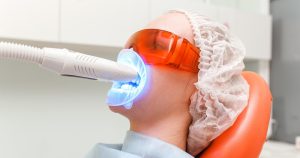When it comes to carbamide peroxide vs hydrogen peroxide for teeth whitening, what’s the difference between the two, and which is best? The main difference between these two chemicals is that carbamide peroxide takes longer to break down.
In this article, we’ll take a deep dive into the issue and address the following:
- The difference between hydrogen and carbamide peroxide
- The pros and cons of each
- Whitening products with carbamide vs hydrogen peroxide
We hope this information helps you decide which tooth whitening product is best for you!


- 97% saw real results after a SINGLE USE
- 100% saw results after their full treatment
- No sensitivity
- 30-day money-back guarantee
- 75+ treatments per box!
What is hydrogen peroxide?
Hydrogen peroxide (H2O2) contains hydrogen and oxygen and is highly reactive. When it is in its purest form, it is a pale blue color. But for most purposes, it must be heavily diluted with water.
Hydrogen peroxide is very reactive when exposed to oxygen. The resulting oxidization means it’s an effective bacteria killer and stain remover. If hydrogen peroxide isn’t diluted, it’s a very strong and dangerous chemical.
In its diluted form, we can use hydrogen peroxide for a wide range of applications, such as bleaching hair, disinfecting shallow cuts, and household cleaning.


One of the other popular applications for hydrogen peroxide is in cosmetic dentistry as the active whitening ingredient in tooth whitening procedures, and that’s what we’re here to talk about today.
Hydrogen peroxide breaks down quickly and works fast to whiten teeth, releasing most of its whitening power within the first 30 to 60 minutes of application in teeth whitening procedures. The fact that hydrogen peroxide works quickly, makes it a more popular option for at-home teeth whitening kits.
What is carbamide peroxide?
Carbamide peroxide is a chemical that is actually made up of hydrogen peroxide and urea, an organic compound found predominantly in animal waste. Urea’s other name is carbamide.


Since hydrogen peroxide is in carbamide peroxide, it too can be used for hair bleaching, household cleaning, and dental bleaching — by breaking down the chemical composition of stains.
Carbamide peroxide breaks down slower than hydrogen peroxide — it releases 50% of its whitening effects during the first 2 hours of application, and the rest over the next 6 hours.
The slow release of carbamide peroxide’s whitening power makes it more popular for in-office or professional tooth whitening procedures.
Carbamide peroxide vs hydrogen peroxide
Since we now know that carbamide peroxide actually contains hydrogen peroxide, it stands to reason that there are plenty of similarities between the two. But there are still some differences as well, which may or may not be important in your search for information.
Similarities
Hydrogen peroxide and carbamide peroxide:
- Are oxidizing agents: Both hydrogen peroxide and carbamide peroxide are reactive when they are exposed to oxygen. It’s this oxidizing process that makes them break down stains, leaving teeth whiter and brighter.
- Whiten teeth: Both chemicals can be effective in whitening teeth, sometimes with very noticeable results, depending on the method and the concentration used.
- May cause sensitivity: Whitening procedures often cause sensitivity, but there is typically no difference in the amount of sensitivity you will notice, whether you are whitening with hydrogen or carbamide peroxide.
- Don’t cause rebound: Rebound is when teeth appear whiter right after a whitening procedure, normally caused by dehydration. Neither carbamide peroxide nor hydrogen peroxide cause rebound.
Tooth discoloration is unfortunately a natural part of the aging process as the enamel on teeth wears down over time due to chewing. This exposes the yellow-colored dentin layer underneath and is the main cause of teeth appearing yellow. But of course, teeth can also become discolored from eating or drinking certain food or beverages and tobacco use.
There are several different options for temporarily restoring the whiteness in your teeth including products that use the ingredients mentioned in this article. As bleaching agents, both hydrogen peroxide and carbamide peroxide are equally effective. Patients treated with carbamide may see quicker results but after a few months go by there is no discernible difference.
Sonya Alvarado, DDS, Full Smile Dental
Differences
There are lots of similarities between hydrogen peroxide and carbamide peroxide, but what about the differences? Let’s have a look at some of the main differences between them.
- Chemical composition: Hydrogen peroxide consists of hydrogen and oxygen. Carbamide peroxide is made up of hydrogen peroxide and urea (carbamide). So carbamide peroxide actually contains hydrogen peroxide in it.
- Speed: Hydrogen peroxide breaks down much quicker than carbamide peroxide, with most of its whitening ability released within the first 30 to 60 minutes. Carbamide peroxide releases half of its whitening power in the first 2 hours of treatment and then continues to be active for up to 6 hours. Ultimately, this means that products with hydrogen peroxide are worn for shorter periods of time during each treatment, but this doesn’t change the length of an actual course of treatment.
- Shelf-life: Carbamide peroxide has a longer shelf life than hydrogen peroxide, but hydrogen peroxide’s shelf-life can be extended with refrigeration.
Pros and cons of each
As we’ve established, both carbamide peroxide and hydrogen peroxide are effective teeth whiteners, but each one has its pros and cons, which we’ll take a closer look at now.
Pros and cons of teeth whitening with hydrogen peroxide
Pros | Cons |
|
|
Pros and cons of teeth whitening with carbamide peroxide
Pros | Cons |
|
|
In the video below, Dr. Jane Gillette from the American Dental Association walks us through the various bleaching ingredients available and talks some more about the similarities and differences between them.
Another option: PAP teeth whitening
Although both hydrogen peroxide and carbamide peroxide are safe and effective ways to whiten teeth (when used in lower concentrations and following the instructions of your dentist or whitening product), there is a newcomer to the market that is quite promising as well.
PAP is the abbreviation for phthalimidoperoxycaproic acid, a non-peroxide whitening agent. Even though it doesn’t contain peroxide, which is the base of most teeth bleaching products, it has been proven to be just as effective as peroxide products.
PAP works to whiten teeth by going through the enamel layer and breaking down color-holding molecules, oxidizing stains, and thus lightening the color of the tooth, just like hydrogen peroxide and carbamide peroxide.
The difference is that peroxides release free radicals during the whitening process, and these can cause sensitivity and in some cases damage your teeth and gum tissue.
PAP, on the other hand, doesn’t release free radicals during the stain oxidization process, and thus some dentists consider it to be safer, and the likelihood of experiencing sensitivity is all but eliminated.
We have a complete guide to whitening teeth with PAP if you are interested in learning more.
Best products for teeth whitening
Now let’s go through our top picks for teeth whitening using hydrogen peroxide, carbamide peroxide, and PAP.


With hydrogen peroxide
Snow is a much-beloved at-home teeth whitening kit that uses LED light technology to activate their whitening gel. The gel contains hydrogen peroxide as the active whitening ingredient.
Snow only takes from 10 to 30 minutes per day of wear, over 21 days to complete treatment. It is able to lighten and eliminate all sorts of stains, including those from tobacco, wine, and coffee. You can read more about Snow in our full Snow review, or check out their wide range of products and famous whitening kits.
With carbamide peroxide


Smile Brilliant is the same teeth whitening treatment you would get at the dentist’s office, but you can use it at home. With Smile Brilliant, you get custom-made whitening trays and professional-strength whitening serum with carbamide peroxide. Since carbamide peroxide takes longer to release its whitening powers, it is recommended that you whiten for up to 3 hours for each treatment.
Because Smile Brilliant is the same treatment you would get from your dentist, it is capable of whitening years and years of the deepest stains. You can read more about Smile Brilliant here. Or you can order your Smile Brilliant kit now.
Conclusion
Hydrogen peroxide and carbamide peroxide are the most common active ingredients you can find in teeth whitening products. They are both effective and safe to use, as long as you follow the instructions.
The main difference is that hydrogen peroxide releases its whitening power faster than carbamide peroxide. Carbamide peroxide, which is a combination of hydrogen peroxide and urea, or carbamide, takes longer to release its whitening power.
Another ingredient being used more often in whitening products is PAP, which doesn’t release any free radicals during the oxidization process, and therefore, causes no sensitivity, which is a problem some people experience with hydrogen peroxide and carbamide peroxide.
FAQs
What is the difference between carbamide peroxide and hydrogen peroxide?
The main difference is that carbamide peroxide takes longer to break down than hydrogen peroxide. Carbamide peroxide also has a longer shelf-life than hydrogen peroxide. Both are effective and safe tooth bleaching solutions.
Where can you buy carbamide peroxide?
Unlike hydrogen peroxide, which you can buy over the counter in low concentrations, carbamide peroxide must be bought as part of a tooth whitening treatment, like Smile Brilliant.
Which works better, hydrogen peroxide or carbamide peroxide?
Hydrogen peroxide and carbamide peroxide achieve the same whitening results. Hydrogen peroxide is often used in at-home whitening kits because it doesn’t require you to wear it very long. Carbamide peroxide is more common with professional whitening treatments because it requires a longer application.
Pubmed: A clinical evaluation of carbamide peroxide and hydrogen peroxide whitening agents during daytime use. Consulted 18th February 2022.




